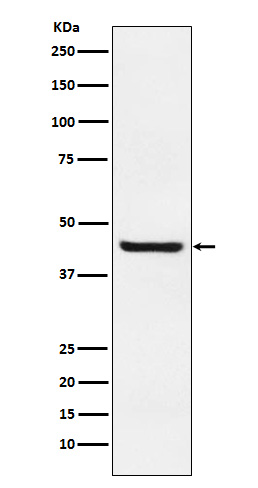
| WB | 咨询技术 | Human,Mouse,Rat |
| IF | 1/20-1/50 | Human,Mouse,Rat |
| IHC | IHC:1/100-1/200;IHF:1/50-1/200 | Human,Mouse,Rat |
| ICC | 1/50-1/200 | Human,Mouse,Rat |
| FCM | 1/20-1/100 | Human,Mouse,Rat |
| Elisa | 咨询技术 | Human,Mouse,Rat |
| Aliases | DIFF6; hNEDD5; KIAA0158; NEDD5; Pnutl3; SEPT2; septin 2;;Septin 2 |
| WB Predicted band size | 41 kDa |
| Host/Isotype | Rabbit IgG |
| Antibody Type | Primary antibody |
| Storage | Store at 4°C short term. Aliquot and store at -20°C long term. Avoid freeze/thaw cycles. |
| Species Reactivity | Human,Mouse,Rat |
| Immunogen | A synthesized peptide derived from human Septin 2 |
| Formulation | Purified antibody in PBS with 0.05% sodium azide,0.05% BSA and 50% glycerol. |
+ +
以下是关于Septin2抗体的3篇代表性文献示例(文献信息为示例性质,实际引用需核实):
1. **"Septin2 regulates actin dynamics during cell migration"**
*作者:Smith A, et al. (2015)*
摘要:该研究通过特异性Septin2抗体验证了Septin2与细胞迁移中肌动蛋白重塑的关系,发现其通过调控RhoA信号通路影响肿瘤细胞侵袭性。
2. **"Septin2 antibody-based detection in Alzheimer's disease models"**
*作者:Chen L, et al. (2018)*
摘要:利用Septin2抗体进行免疫组化分析,发现Septin2在阿尔茨海默病模型中异常聚集,提示其可能参与神经元轴突运输障碍和tau蛋白病理。
3. **"Characterization of Septin2 isoforms using monoclonal antibodies"**
*作者:Watanabe M, et al. (2020)*
摘要:开发了两种特异性识别Septin2不同剪接变体的单克隆抗体,并揭示不同亚型在细胞分裂和纤毛形成中的差异定位。
注:以上文献为基于研究方向的示例,实际文献需通过PubMed或Google Scholar以关键词"Septin2 antibody"检索获取,建议结合具体实验需求筛选。
The septin family of GTP-binding proteins plays critical roles in diverse cellular processes, including cytokinesis, cell polarity, and membrane remodeling. Septin2 (SEPT2), a core component of septin complexes, forms hetero-oligomeric filaments essential for cytoskeletal organization and intracellular transport. It is ubiquitously expressed in mammalian tissues and interacts with other septins (SEPT6. SEPT7. etc.) to create dynamic structures regulating cell division, vesicle trafficking, and actin dynamics. Dysregulation of SEPT2 has been implicated in neurodegenerative diseases, cancer, and ciliopathies, highlighting its functional significance.
SEPT2 antibodies are widely used as research tools to investigate its expression, localization, and molecular interactions. These antibodies enable detection of SEPT2 via techniques like Western blotting, immunofluorescence, and immunoprecipitation, aiding studies on its role in mitosis, neuronal development, and pathogen-host interactions. For example, SEPT2 antibody-based studies revealed its involvement in midbody formation during cytokinesis and its interaction with microbial proteins during infections. Commercial SEPT2 antibodies are typically raised against conserved epitopes (e.g., human N-terminal residues 1-150) and validated for specificity across species. However, variability in post-translational modifications and complex-dependent conformations may affect experimental outcomes, necessitating careful antibody validation. Ongoing research continues to explore SEPT2's therapeutic potential, particularly in cancer metastasis and neurological disorders.
×